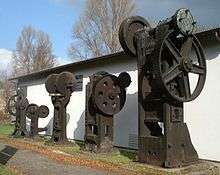Machine Age

Metalworking machinery

A freight locomotive

Bonneville Dam (1933-37)
The Machine Age[1][2][3] is an era that includes the early 20th century, sometimes also including the late 19th century. An approximate dating would be about 1880 to 1945. Considered to be at a peak in the time between the first and second world wars, it forms a late part of the Second Industrial Revolution. By the mid to late 1940s, the atom bomb,[4] the first computers,[5] and the transistor came into being,[6] beginning the contemporary era of Digital Revolution and thus ending the intellectual model of the machine age founded in the mechanical and heralding a new more complex model of high technology.
Universal chronology

Developments
Artifacts of the Machine Age include:
- Mass production of high-volume goods on moving assembly lines, particularly of the automobile[7]
- Gigantic production machinery, especially for producing and working metal, such as steel rolling mills, bridge component fabrication, and automobile body presses
- Powerful earthmoving equipment
- Steel framed buildings of great height (the skyscraper[8])
- Radio and phonograph technology
- High speed printing presses, enabling the production of low cost newspapers and mass market magazines
- Large hydroelectric and thermal electric power production plants and distribution systems
- Low cost appliances for the mass market that employ fractional horsepower electric motors, such as the vacuum cleaner and the washing machine
- Fast and comfortable long distance travel by railroad, automobile, and aircraft
- Development and employment of modern war machines such as tanks, aircraft, submarines and the modern battleship
- Streamline designs in automobiles and trains, influenced by aircraft design
Social influence
- The rise of mass market advertising and consumerism
- Nationwide branding and distribution of goods, replacing local arts and crafts
- Nationwide cultural leveling due to exposure to movies and network broadcasting
- Replacement of skilled crafts with low skilled labor
- Growth of strong corporations through their abilities to exploit economies of scale in materials and equipment acquisition, manufacturing, and distribution
- Corporate exploitation of labor leading to the creation of strong trade unions as a countervailing force
Environmental influence
- Exploitation of natural resources with little concern for the ecological consequences; a continuation of 19th century practices but at a larger scale.
- Release of synthetic dyes, artificial flavorings, and toxic materials into the consumption stream without testing for adverse health effects.
International relations
- Conflicts between nations regarding access to energy sources (particularly oil) and material resources (particularly iron and various metals with which it is alloyed) required to ensure national self-sufficiency. Such conflicts were contributory to two devastating world wars.
Arts and architecture

Nude Descending a Staircase, No. 2 (1912) by Marcel Duchamp displays Cubist and Futurist characteristics
The Machine Age is considered to have influenced:
- Dystopian movies including Chaplin's Modern Times and Lang's Metropolis
- Streamline Moderne appliance design and architecture
- Bauhaus style
- Steampunk
- Modern art
See also
References
- ↑ Mentality and freedom By William Armstrong Fairburn. Page 219.
- ↑ The Playground, Volume 15 By Playground and Recreation Association of America
- ↑ Public libraries, Volume 6
- ↑ http://www.capitalcentury.com/1944.html
- ↑ http://www.scl.ameslab.gov/ABC/Articles/First-computer.html
- ↑ http://www.cedmagic.com/history/transistor-1947.html
- ↑ "Industrialization of American Society". Engr.sjsu.edu (College of Engineering, San José State University). Retrieved 2013-08-14.
- ↑ "The Plan Comes Together - Encyclopedia of Chicago". Encyclopedia.chicagohistory.org. Retrieved 2013-08-14.
This article is issued from Wikipedia - version of the 10/16/2016. The text is available under the Creative Commons Attribution/Share Alike but additional terms may apply for the media files.